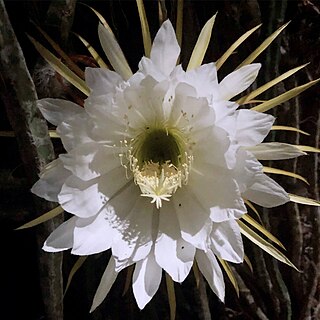
Night-blooming cereus is the common name referring to a large number of flowering ceroid cacti that bloom at night. The flowers are short lived, and some of these species, such as Selenicereus grandiflorus, bloom only once a year, for a single night, though most put out multiple flowers over a period of several weeks, each of which opens for only a single night. Other names for one or more cacti with this habit are princess of the night, Honolulu queen, Christ in the manger, dama de noche, and queen of the night.

Epiphyllum is a genus of epiphytic plants in the cactus family (Cactaceae), native to Central America and South America. Common names for these species include climbing cacti, orchid cacti and leaf cacti, though the latter also refers to the genus Pereskia.

The term ceroid cactus is used to describe any of the species of cacti with very elongated bodies, including columnar growth cacti and epiphytic cacti. The name is from the Latin cēreus, meaning "wax taper ", referring to the stiff, upright form of the columnar species. Some species of ceroid cacti were known as torch cactus or torch-thistle, supposedly due to their use as torches by Native Americans in the past.
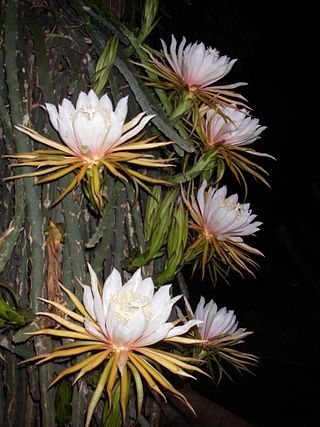
Hylocereus is a former genus of epiphytic cacti, often referred to as night-blooming cactus. Several species previously placed in the genus have large edible fruits, which are known as pitayas, pitahayas or dragonfruits. In 2017, a molecular phylogenetic study confirmed an earlier finding that the genus Hylocereus was nested within Selenicereus, so all the species of Hylocereus were transferred to Selenicereus.

Selenicereus, sometimes known as moonlight cactus, is a genus of epiphytic, lithophytic, and terrestrial cacti, found in Mexico, Central America, the Caribbean and northern South America. The term night-blooming cereus is also sometimes used, but this is also used for many night-blooming cacti, including Epiphyllum and Peniocereus. In 2017, the genus Hylocereus was brought into synonymy with Selenicereus. A number of species of Selenicereus produce fruit that is eaten. The fruit, known as pitaya or pitahaya in Spanish or as dragon fruit, may be collected from the wild or the plants may be cultivated.

Disocactus crenatus, the crenate orchid cactus, is a species of cactus and a critical parent plant in creating the epiphyllum hybrids commonly cultivated worldwide. It is cultivated for its large flowers.

Epiphyllum oxypetalum, the Dutchman's pipe cactus, princess of the night or queen of the night, is a species of cactus with a native range from Mexico to Nicaragua. It blooms nocturnally, and its flowers wilt before dawn. Though it is sometimes referred to as a night-blooming cereus, it is not closely related to any of the species in the tribe Cereeae, such as Selenicereus, that are more commonly known as night-blooming cereus. All Cereus species bloom at night and are terrestrial plants; Epiphyllum species are usually epiphytic.

Selenicereus hamatus is a species of Cactaceae and produces one of the largest flowers in the family. It is a cultivated ornamental vine. The species is native to Mexico.
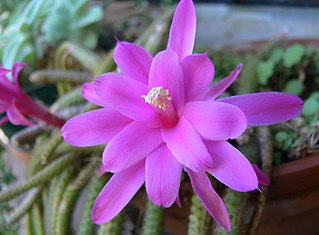
Aporocactus flagelliformis, the rattail cactus, is a species of flowering plant in the cactus family Cactaceae, and is the most cultivated species in the genus Aporocactus. Due to its ease of cultivation and attractive floral displays, it is often grown as an ornamental potted plant.

Disocactus phyllanthoides, the nopalxochitl or German empress, is a species of flowering plant in the cactus family Cactaceae. It is commonly grown as an ornamental houseplant. It is one of the three major species involved in creating the widely grown epiphyllum hybrids or "epis". The others are Disocactus speciosus and Disocactus crenatus.

Selenicereus spinulosus is a cactus species native to eastern Mexico and, possibly, the lower Rio Grande Valley of Texas in the United States. Common names include vine-like moonlight cactus and spiny moon cereus. Its specific name, spinulosus, means "with small spines" in Latin.

Selenicereus costaricensis, synonym Hylocereus costaricensis, known as the Costa Rican pitahaya or Costa Rica nightblooming cactus, is a cactus species native to Central America and north-eastern South America. The species is grown commercially for its fruit, called pitaya or pitahaya, but is also an impressive ornamental vine with huge flowers. The species may not be distinct from Selenicereus monacanthus.
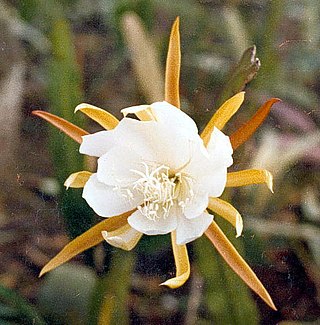
Epiphyllum laui is a cactus species native to Mexico and grown as an ornamental.
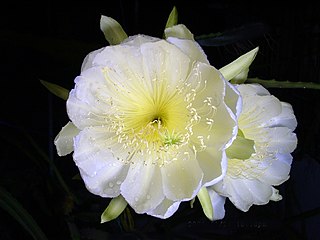
Selenicereus megalanthus, synonym Hylocereus megalanthus, is a cactus species in the genus Selenicereus that is native to northern South America, where it is known, along with its fruit, by the name of pitahaya. The species is grown commercially for its yellow fruit, but is also an impressive ornamental climbing vine with perhaps the largest flowers of all cacti.
Bipolaris cactivora is a plant pathogen causing cactus stem rot and pitaya fruit rot.

Epiphyllum pumilum is a cactus species native to Mexico and Guatemala. The species is commonly grown as an ornamental for its beautiful, fragrant flowers in the summer.

Selenicereus grandiflorus is a cactus species originating from the Antilles, Mexico and Central America. The species is commonly referred to as queen of the night, night-blooming cereus, large-flowered cactus, sweet-scented cactus or vanilla cactus. The true species is extremely rare in cultivation. Most of the plants under this name belong to other species or hybrids. It is often confused with the genus Epiphyllum.

A pitaya or pitahaya is the fruit of several different cactus species indigenous to the region of southern Mexico and along the Pacific coasts of Guatemala, Costa Rica, and El Salvador. Pitaya is cultivated in East Asia, South Asia, Southeast Asia, the United States, the Caribbean, Australia, Brazil, and throughout tropical and subtropical regions of the world.

Echinocereus stramineus is a species of cactus, with stramineus meaning made of straw. There are various common names such as strawberry cactus, porcupine hedgehog cactus, straw-color hedgehog, and pitaya. The straw-colored spines distinguishes this particular plant from other Echinocereus. The aged spines may turn white in color and are very fragile.
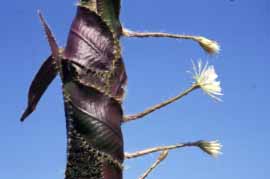
Strophocactus wittii, synonym Selenicereus wittii, known as the Amazon moonflower, is a species of plant in the genus Strophocactus in the cactus family (Cactaceae), and is one of several species commonly called "moonflowers". It was first described in 1900 and is one of three species of cactus found in the central Amazon basin.




























